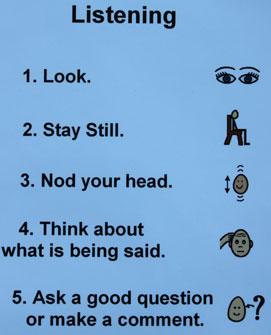What it is
An area of student need, involving difficulty with receptive processing of oral information.
Teaching Strategies

Instructional
• Provide extra time for processing of oral information.
• Pair oral instructions with visual ones (writing or symbols).
• Develop a cue for the student to focus on listening before important information is given (“Stop, look and listen,” or turning the lights off and on).
• Pre-teach new vocabulary and regularly review previously taught vocabulary.
• frequently check with the student for understanding.
• Use Differentiated Instruction to teach lessons in a variety of ways.
• Use repetition frequently and ask the student to repeat information back in his/her own words.
• Provide copies of notes.
• Use graphic organizers.
• Reward efforts for increased listening.
• Develop and implement an alternative programming goal for the student to increase listening comprehensions skills.
• teach direct lessons in listening comprehensions skills (likely the whole class would benefit).
• Use clear and concise language.
• Consider referral to a speech and language pathologist.
Less...
More...

Environmental
• Reduce auditory distractions in the classroom.
• Use preferential seating to limit distractions.
• Post reference information for student to use (charts, schedule, etc.).

Assessment
• Ensure student understands test/assignment questions.
• Provide written instructions and rubrics for assignments.
• Provide a choice of assessment activities so that the student can select one related to his/her strengths.
• Provide a reference sheet or vocabulary and/or a dictionary for tests.
Resources







